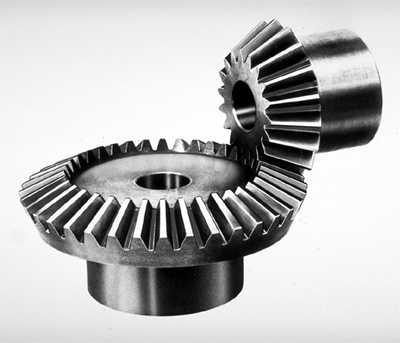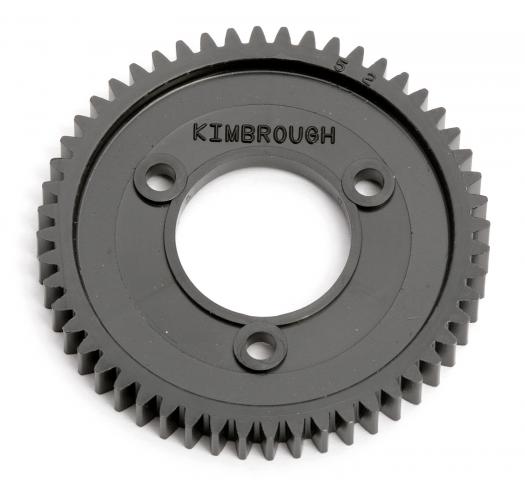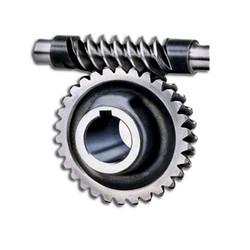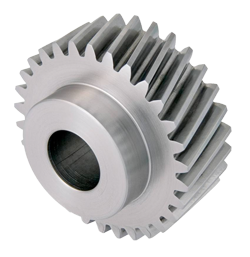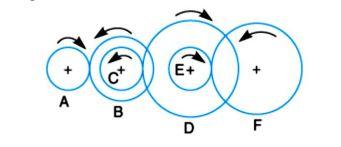How Well You Know About Gears? Trivia Quiz
(17).jpg)
How well do you know about gears? During this quiz, you will need to know the difference between a spur gear, a helical gear, bevel gear, and worm gear, how to use a diagram to calculate the gear ratio of the compound gear train, how to calculate a speed ratio, and what is an algorithm. Get in gear and take this quiz.
- 1.
What type of gear is illustrated here?
- A.
Spur Gear
- B.
Helical Gear
- C.
Bevel Gear
- D.
Rack and Pinion
- E.
Worm Gear
- F.
Hypoid Gear
Correct Answer
C. Bevel GearExplanation
The gear illustrated in the given image is a bevel gear. Bevel gears are used to transmit power between intersecting shafts and are characterized by their cone-shaped teeth. They are commonly used in applications where the direction of rotation needs to be changed, such as in automotive differentials or power tools.Rate this question:
-
- 2.
What type of gear is illustrated here?
- A.
Spur Gear
- B.
Helical Gear
- C.
Bevel Gear
- D.
Rack and Pinion
- E.
Worm Gear
- F.
Hypoid Gear
Correct Answer
A. Spur GearExplanation
The gear illustrated in the image is a Spur Gear. Spur gears are the most common type of gears and have straight teeth that are parallel to the gear axis. They are used to transmit motion and power between parallel shafts.Rate this question:
-
- 3.
What type of gear is illustrated here?
- A.
Spur Gear
- B.
Helical Gear
- C.
Bevel Gear
- D.
Rack and Pinion
- E.
Worm Gear
- F.
Hypoid Gear
Correct Answer
E. Worm GearExplanation
A worm gear is a type of gear that consists of a helical thread (worm) and a gear wheel (worm wheel) meshing together. The illustration in the question shows a gear with a helical thread wrapped around it, indicating that it is a worm gear. Worm gears are commonly used in applications where a high gear ratio is required, such as in conveyor systems and lifting mechanisms. They provide a compact and efficient way to transmit motion and power between non-parallel shafts.Rate this question:
-
- 4.
What type of gear is illustrated here?
- A.
Spur Gear
- B.
Helical Gear
- C.
Bevel Gear
- D.
Rack and Pinion
- E.
Worm Gear
- F.
Hypoid Gear
Correct Answer
B. Helical GearExplanation
The gear illustrated in the question is a helical gear. This can be determined by observing the shape of the teeth. Helical gears have angled teeth that are cut in a helix shape, which allows for smoother and quieter operation compared to spur gears. The other options, such as bevel gear, rack and pinion, worm gear, and hypoid gear, have different tooth arrangements and shapes that are not depicted in the given illustration.Rate this question:
-
- 5.
Use the diagram to calculate the gear ratio of the compound gear train.T=TeethTa=20; Tb=50; Td=75;Te=26; Tf=65
- A.
25:1
- B.
16:1
- C.
20:1
- D.
7:1
Correct Answer
D. 7:1Explanation
The gear ratio of a compound gear train is calculated by multiplying the individual gear ratios of each pair of gears in the train. In this case, the gear ratio can be calculated as follows:
Gear ratio = (Te/Ta) * (Td/Tb) * (Tf/Te)
= (26/20) * (75/50) * (65/26)
= 1.3 * 1.5 * 2.5
= 4.875
Since the gear ratio is not exactly equal to any of the given options, the closest option is 7:1.Rate this question:
-
- 6.
An idler gear is a gear that will remain still in a gear train while other gears are engaged and turn.
- A.
True
- B.
False
Correct Answer
B. FalseExplanation
An idler gear is a gear that is placed between two other gears in a gear train. It does not remain still, but rather rotates freely to transmit motion between the two adjacent gears. The purpose of an idler gear is to change the direction of rotation or adjust the spacing between the other gears. Therefore, the given statement is false.Rate this question:
-
- 7.
Check all that can be used in calculating a speed ratio for a gear train?
- A.
Length of teeth of drivers and length of teeth of drivens.
- B.
Radius of drivers and radius of drivens.
- C.
Teeth of drivers and teeth of drivens
- D.
Rotations of drivers (deg) and rotations of drivens (deg)
- E.
Speed of drivers (rpm) and speed of drivens (rpm).
Correct Answer(s)
B. Radius of drivers and radius of drivens.
C. Teeth of drivers and teeth of drivens
D. Rotations of drivers (deg) and rotations of drivens (deg)
E. Speed of drivers (rpm) and speed of drivens (rpm).Explanation
The speed ratio of a gear train can be calculated using the radius of drivers and radius of drivens, teeth of drivers and teeth of drivens, rotations of drivers (deg) and rotations of drivens (deg), and speed of drivers (rpm) and speed of drivens (rpm). These factors are all related to the gear sizes and rotations, which determine the speed and torque transmission in a gear train. The length of teeth of drivers and length of teeth of drivens is not relevant for calculating the speed ratio.Rate this question:
-
- 8.
Check the boxes to the left of all the options that refer to an initial steps of a programmer in the development a working piece of code.
- A.
Algorithm
- B.
Pseudocode
- C.
Code
- D.
Flow Chart
- E.
Process Analysis
- F.
Identify Variables
Correct Answer
A. AlgorithmExplanation
The correct answer is "Algorithm". An algorithm is a step-by-step procedure or set of rules for solving a specific problem or accomplishing a specific task. It is the initial step in the development of a working piece of code as it helps in planning and organizing the logical flow of the code before actually writing the code. It defines the problem, identifies the inputs and outputs, and outlines the sequence of steps to be followed to achieve the desired outcome.Rate this question:
-
Quiz Review Timeline +
Our quizzes are rigorously reviewed, monitored and continuously updated by our expert board to maintain accuracy, relevance, and timeliness.
-
Current Version
-
Mar 21, 2023Quiz Edited by
ProProfs Editorial Team -
Sep 09, 2015Quiz Created by
Stephen Miele
- Aeronautics Quizzes
- Aerospace Quizzes
- Agricultural Science Quizzes
- Astrology Quizzes
- Astronomy Quizzes
- Atom Quizzes
- Biochemistry Quizzes
- Biology Quizzes
- Biomechanics Quizzes
- Biostatistics Quizzes
- Biotechnology Quizzes
- Botany Quizzes
- Branches Of Science Quizzes
- Cytology Quizzes
- Easy Science Quizzes
- Ecology Quizzes
- Electrical Quizzes
- Embryology Quizzes
- Endocrinology Quizzes
- Engineering Quizzes
- Environmental Science Quizzes
- Epidemiology Quizzes
- Experiment Quizzes
- Forestry Quizzes
- Fossil Quizzes
- Gas Quizzes
- General Science Quizzes
- Genetics Quizzes
- Histology Quizzes
- Human Biology Quizzes
- Integrated Science Quizzes
- Invention Quizzes
- Library Science Quizzes
- Lighting Quizzes
- Liquid Quizzes
- Marine Biology Quizzes
- Microbiology Quizzes
- Molecular Biology Quizzes
- Nature Quizzes
- Neuroscience Quizzes
- Nuclear Science Quizzes
- Oceanography Quizzes
- Psychology Quizzes
- Science And Technology Quizzes
- Science Glossary Quizzes
- Science Knowledge Quizzes
- Science Practice Quizzes
- Scientific Method Quizzes
- Scientific Notation Quizzes
- Soil Science Quizzes
- Solar System Quizzes
- Solid Quizzes
- Zoology Quizzes
 Back to top
Back to top



